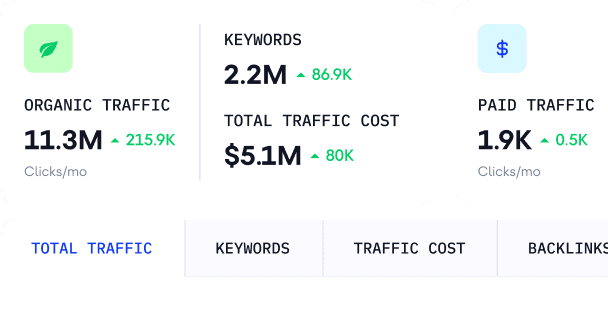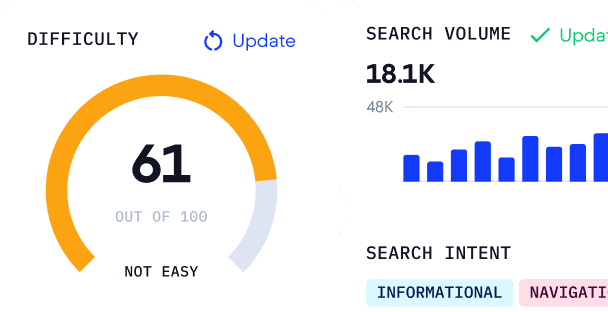Healthcare SEO guide: Strategies and tactics for medical providers
Just like your physical health needs maintenance and preventative care, your healthcare website’s well-being requires optimization “treatments.” Otherwise, it could end up in a similar situation to that of an intensive care patient. Devising an effective healthcare SEO strategy can be your preventative pill.
In this guide, we’ll explain how to properly “treat” your website with medical SEO tactics, ensuring it embodies healthiness and serves your patients well. We’ll cover the healthcare SEO fundamentals, provide examples, and share hands-on tips.
Key takeaways:
- Performing SEO for hospitals, medical practices, and other healthcare institutions requires extra care and heavy emphasis on credible, accurate, and expertly written or reviewed content.
- Focus on building your authoritativeness and trustworthiness by showing your team’s credentials, qualifications, experience, certificates, etc., and getting mentions from reliable sources.
- Make your medical website friendly to both your patients and search engines through intuitive and logical navigation, accessible content, and aligning with search intent.
- Improve your practice’s local visibility by optimizing for local search, getting featured in local listings, and managing patient reviews.
- Ensure your website maintains optimal performance by regularly conducting SEO audits to identify and resolve issues such as broken links, duplicate content, and crawl errors.
What is healthcare SEO?
Healthcare SEO (search engine optimization) refers to the strategies used to increase the visibility of hospitals and healthcare institutions in search engine results pages (SERPs). As your medical website ranks higher for relevant keywords, it receives more traffic from people searching for doctors, hospitals, health issues, services, treatments, and other healthcare-related information online.
What makes SEO for the healthcare industry unique?
SEO for medical industry websites requires deeper levels of care. The health and well-being of your users depend on it, as providing the wrong information can have serious consequences.
Here are some critical factors setting SEO for medical practice apart:
- The need for credible and carefully crafted content
Healthcare content isn’t judged by the same standards as other industries because it falls under Google’s YMYL (Your Money or Your Life) category for Google. This kind of content can have a drastic effect on human lives. Since people’s search queries in this field revolve around advice on diagnosing conditions, understanding treatments, and improving overall health, misinformation can put their health at risk. Your content must be accurate, factual, backed by medical consensus, and reviewed by credentialed experts in the field.
Like healthcare, the legal field falls under Google’s YMYL categories, which require strong expertise and trust signals. For a look at SEO in another high-trust industry, explore our SEO for lawyers guide.
- Proving your expertise and trustworthiness
Major search engines like Google prioritize the most authoritative and trustworthy sources, placing them at the top of search results. This makes building a strong E-E-A-T (Experience, Expertise, Authoritativeness, Trustworthiness) profile crucial for your medical SEO strategy. Since Google places extra emphasis on evaluating E-E-A-T signals for YMYL sites, you need to demonstrate that you have a solid reputation for providing reliable health guidance.
- Ensuring accessibility for all
Many of the people visiting your website are dealing with various disabilities, impairments, and health conditions. The World Health Organization (WHO) estimates that around 16% of the global population lives with some form of disability, which is a huge potential audience. To serve them properly, you must optimize for accessibility. Providing an inclusive user experience is essential to forming a well-rounded SEO strategy.
Why it’s worth investing in SEO for healthcare businesses
Look at how today’s consumers approach finding and vetting medical care online:
- 61% of patients use the Internet when researching healthcare providers and almost 80% rely on two or more online resources.
- 69% of millennials look for medical advice online first, and 37% won’t see a doctor who doesn’t have an online presence.
- 72% of patients check online reviews when selecting a new medical provider.
With so many people heavily relying on online information to make health-related decisions, you can’t afford to let your practice fall off their radar. Maintaining a strong healthcare SEO strategy keeps you visible and accessible to potential patients.
Below are some major benefits of SEO for doctors:
- Increased web traffic and brand visibility: Proper medical search engine optimization makes your website more visible in search engine results when people search using specific keywords. Individuals might search for conditions, treatments, and local providers. If your website is optimized for these keywords, its chances of being found by your potential clients increase.
- More potential patients: As more people use search results to discover and click on your website, more leads enter your sales funnel. This expands your patient base.
- More trust and credibility: Patients may see your high-ranking website as a credible source of medical advice that provides quality care they can rely on.
- Cost-effective long-term results: While paid ads have their place, SEO continues to deliver results without ongoing ad costs. Even though SEO may not be free or the cure-all for healthcare search engine marketing, it is a great source of traffic that your business shouldn’t ignore.
Healthcare SEO roadmap: 8 steps to ranking higher in search engines
Just like SEO for dental practices, SEO for doctors has a distinct influence on human lives (YMYL, as mentioned earlier). Healthcare sites must focus on quality content and E-E-A-T, both of which are points that we will cover below. We will also look at other important healthcare search engine optimization tactics.
Find and analyze your competitors
Before prescribing an effective SEO treatment, you need to understand what’s working (or not) in your specific niche, identify your competitors, and find out how your rivals conduct their business and SEO. Researching your competition is a reliable diagnostic method for retrieving useful information about your site’s health relative to others.
The easiest way to find your primary competitors is through SE Ranking’s Competitor Analysis Tool. Just enter your medical website address and hit the Analyze button.
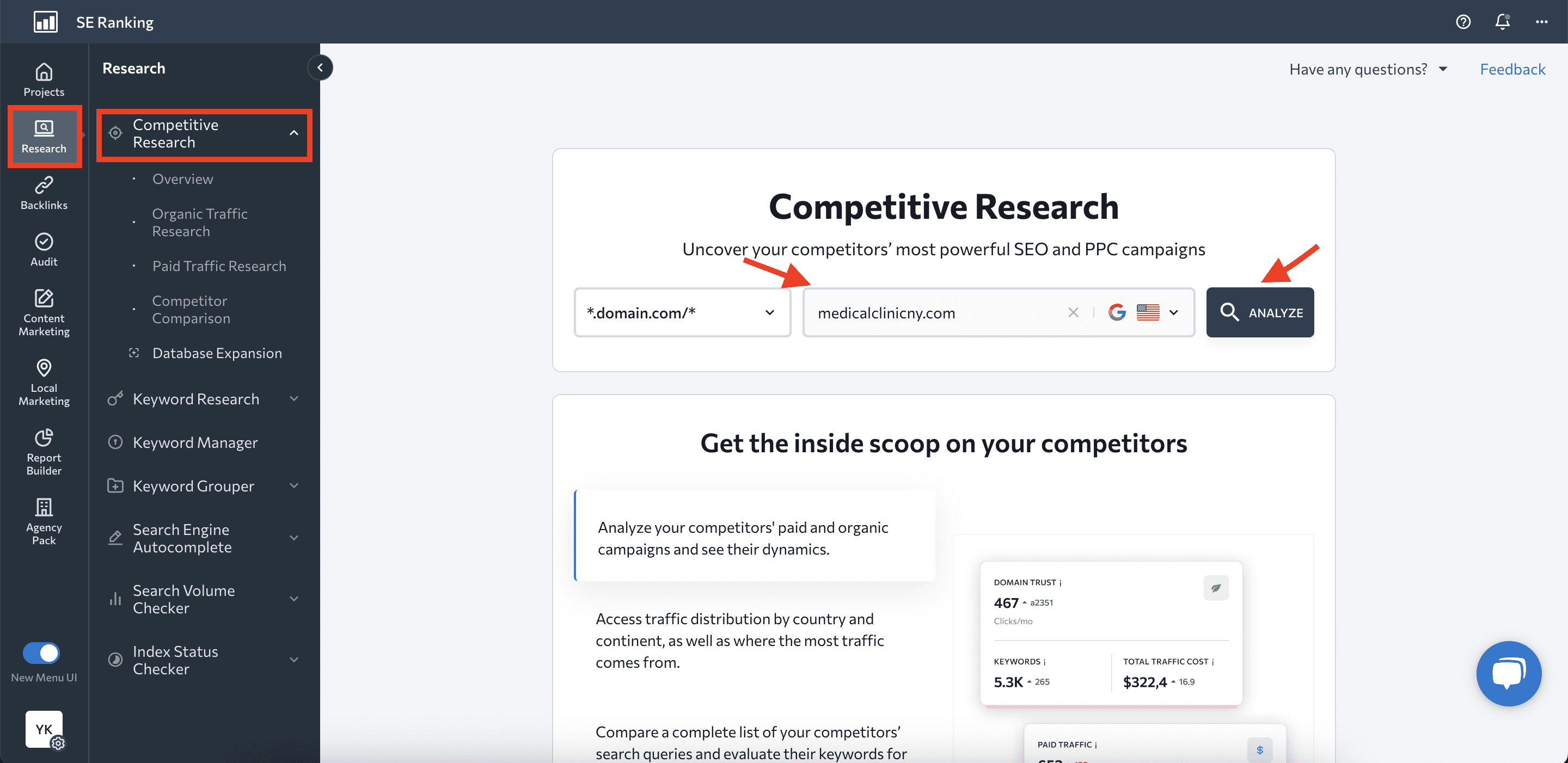
Once the analysis is completed, go to the Organic Traffic Research section and open the Competitors tab.
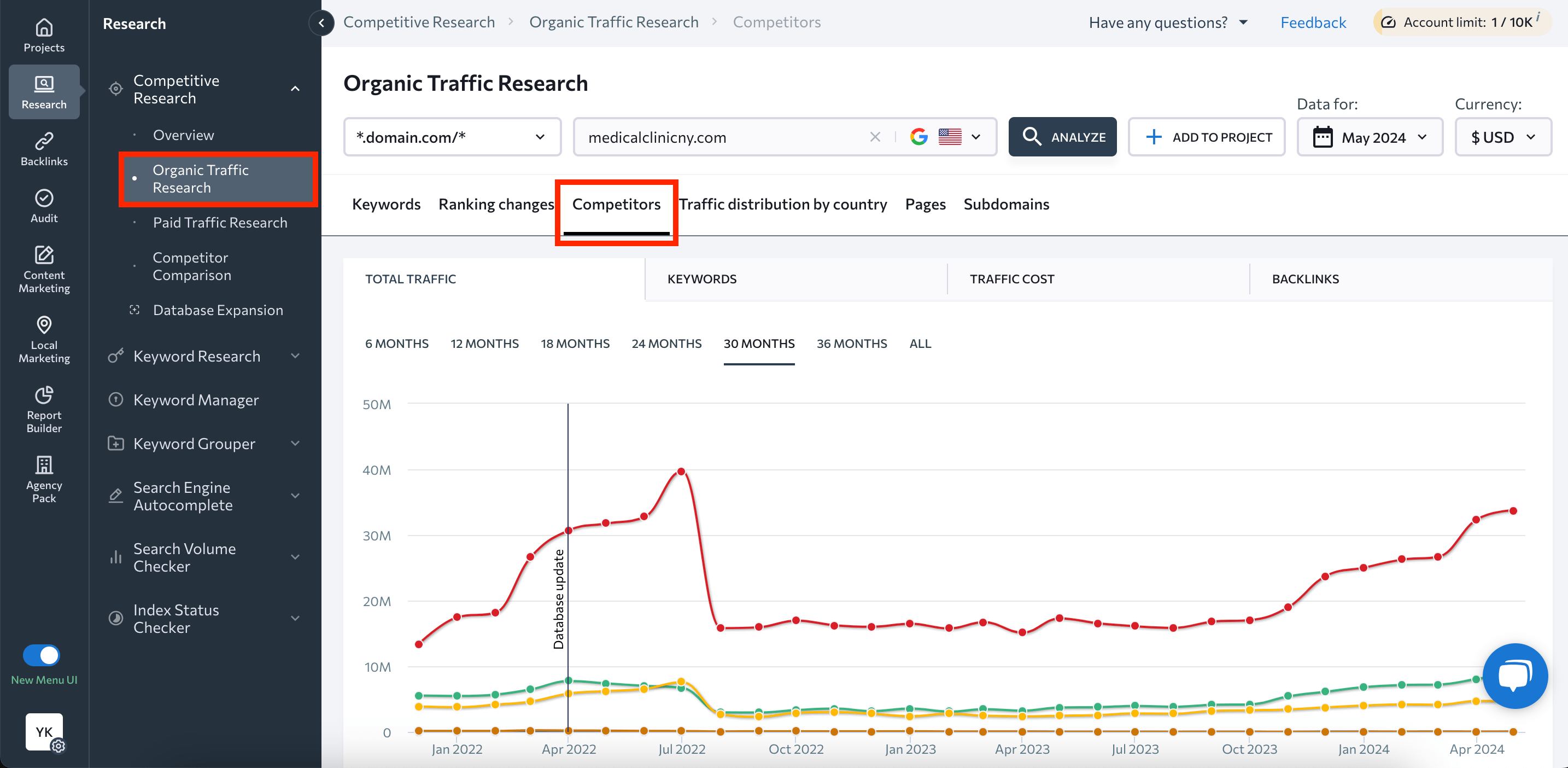
It will display below the graph a list of your top Google rivals. You can benchmark metrics like:
- Domain Trust (SEO score showing any domain’s likelihood of ranking in search results)
- Total number of keywords
- Keywords you have in common
- Competitive keywords missing from your strategy
- Total traffic and its cost
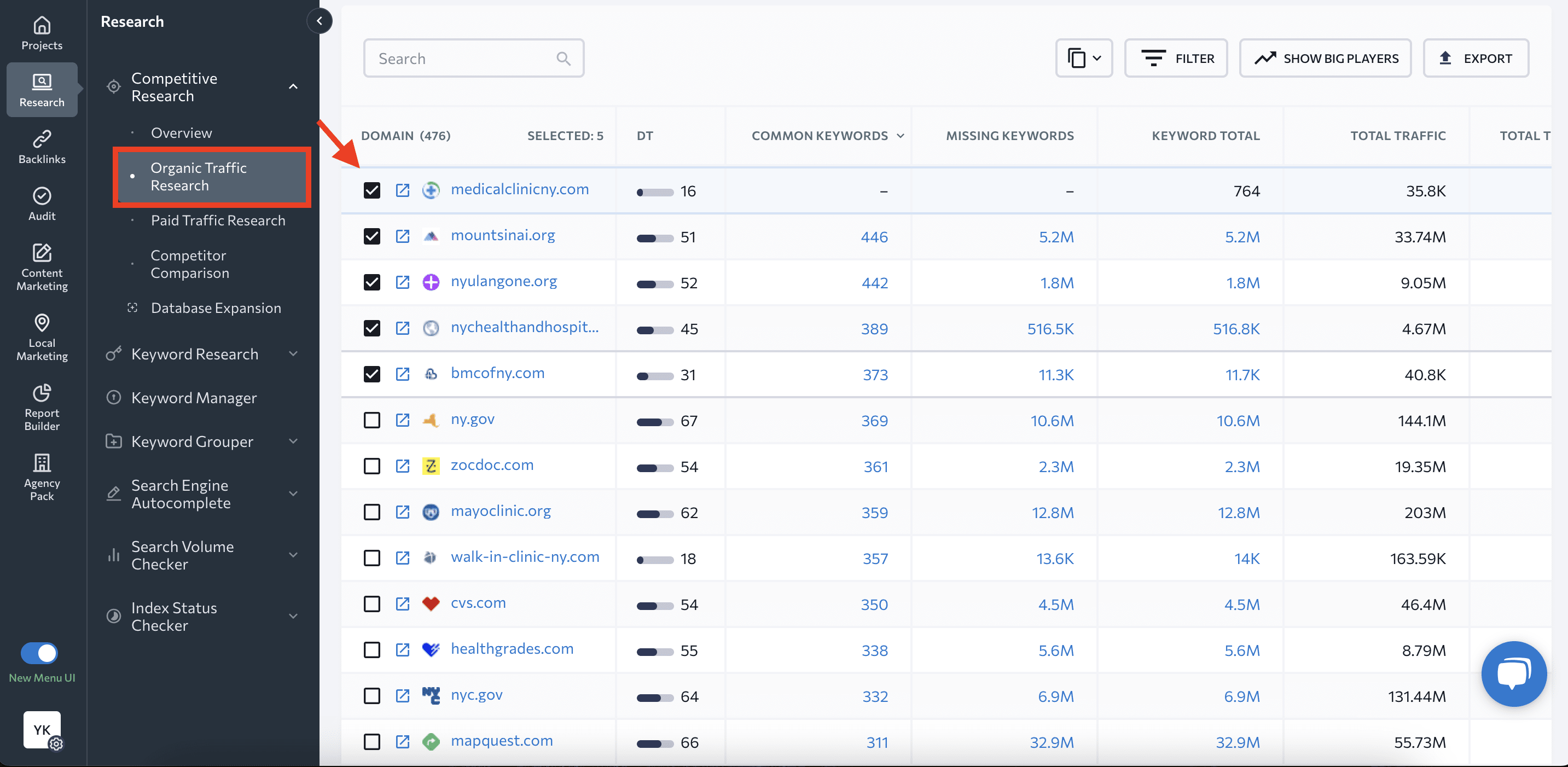
From here, go directly to your competitor to review the site architecture and content. You can also run a competitor analysis separately to analyze SEO metrics like traffic, keywords, ranking changes, top pages, etc. We recommend doing both. We also recommend checking the website’s structure with the Website Audit tool. This quick and easy method helps you better understand your competitor’s structural approaches.
Another smart tactic is to enter your seed keywords into SE Ranking’s Keyword Search Tool. Check the Organic Results report to see who’s currently dominating the SERPs for those terms and based on content type. This tool also enables you to analyze the URLs and titles used by your rivals.
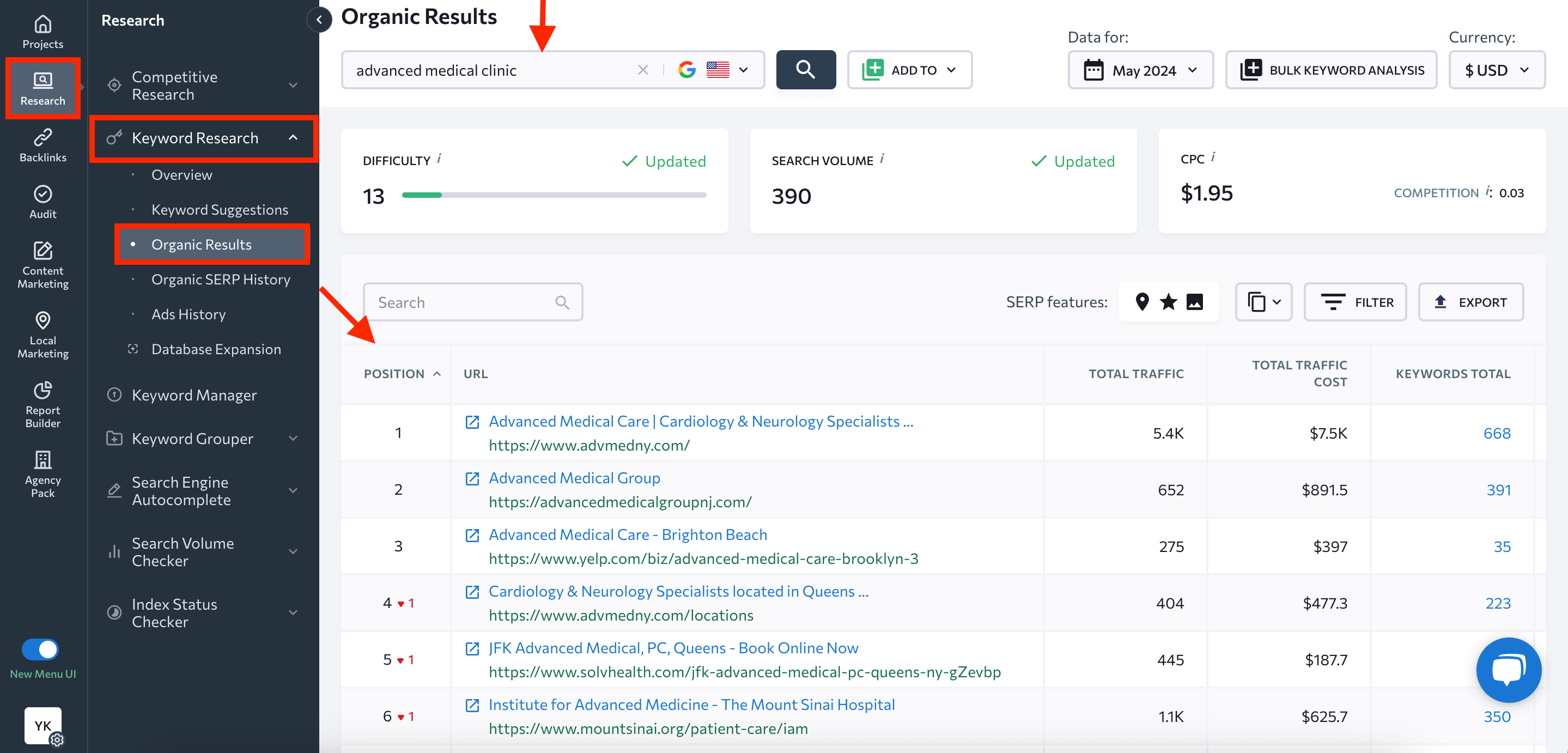
Once you know your competitors, you can:
- Identify the pages bringing the most organic traffic to their websites.
- Discover strengths and weaknesses in their content and website structure.
- Find competitor keywords and identify their keyword gaps.
- Study (to then partly replicate) their off-page tactics (optimization efforts that happen outside a website, like getting mentions and backlinks).
Create top-quality medical content
Compile a list of search terms that align with your services and with what your potential patients are searching for. This list could include queries on specific conditions, treatments, healthcare offerings, etc.
For instance, if you’re running a primary care hospital in New York, target keywords like:
- Best primary care physicians in New York
- Affordable New York general practitioner
- Primary care doctor NYC
These are the top commercial/transactional queries but consider targeting relevant informational or other types of keywords:
- What is a family medicine doctor
- Pediatric care guidelines
- Immunization schedules for children
If you own a diabetes hospital in London, add terms like:
- London diabetes treatment
- Type 2 diabetes specialist in London
- London diabetic care advice
Pay attention to keyword metrics. Find relevant terms with low competition levels and decent search volumes (how often the keyword is searched for). These queries are easier to rank for and can drive organic traffic to your website.
Analyze your competitors’ top traffic-driving pages and content types traffic. Reverse-engineering their successful strategies can help you determine which page types and topics to prioritize on your site.
Now it’s time to create content for your website!
Healthcare professionals should follow the advice below:
- Prove your authority and expertise by offering insightful, well-researched, and evidence-based perspectives.
- Ensure accuracy by having certified medical experts who can write or review content.
- Focus each piece of content on a single search intent, rather than trying to target multiple intents. This delivers more helpful and engaging content for users.
- Audit your content regularly to find outdated or incomplete content pieces. Refresh them to align with the latest verified medical information.
- Avoid duplicate content (large blocks of text that repeat across different web pages) as it can hurt your SEO efforts. If you need to use information that appears elsewhere, modify it and add unique insights that expand upon the existing information.
- Properly cite sources.
- Prioritize helpful content over thoughtless AI generation. Patients are searching for an expert voice, machine-generated generic texts. While some AI tools can produce decent rough drafts, you must review them thoroughly, add a personal touch, and fill them with real-life expert perspectives.
Let’s move on to creating the types of content that get traffic to your site:
- Create service pages to attract commercial (transactional) traffic
These pages provide detailed information about your services, the benefits of choosing your hospital, how to book an appointment, etc. The idea is to convert your website visitors into potential patients.
Let’s review some examples below.
London Medical offers dermatology services to its patients. It created a separate service page (https://londonmedical.co.uk/dermatology/) detailing the conditions it treats (acne, psoriasis, skin cancer, etc.) and the dermatology services it provides (pediatric dermatology, cosmetic dermatology). This page also includes a team description and how to book a consultation.
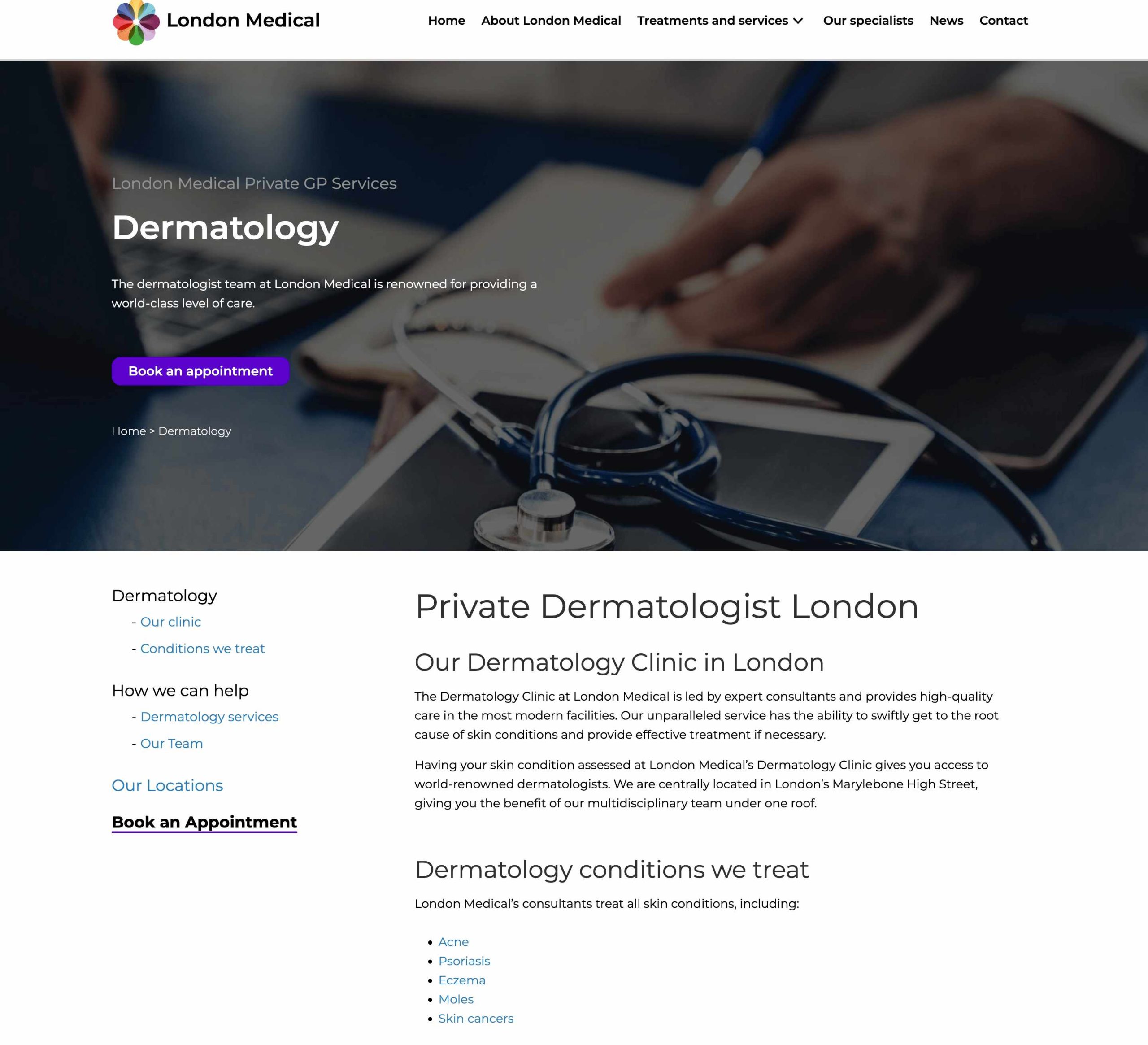
NY Best Medical has a dedicated page about physical exams: https://www.nybestmedical.com/services/pre-employment-physicals/. The clinic highlights the exams it offers patients, why they are necessary, the benefits of choosing this clinic, and how to schedule a visit.
- Create posts on your healthcare blog to attract informational traffic
Blog posts attract users who are looking for information. These users might not be ready to book an appointment but are researching symptoms, treatments, or health tips. Your articles should answer their questions and be optimized for relevant healthcare keywords.
Check out this blog post about forehead acne on London Medical’s website. It explains the causes of forehead acne, types of acne, and treatment options. The end of the post includes a CTA encouraging users to book an appointment. This is meant to convert traffic into leads. It also lists the sources used when writing the article, which is even more important for building trust. This shows that the information is based on research and can be trusted.
One way to streamline the healthcare content creation process is to use online tools like SE Ranking’s Content Editor. This tool helps you craft SEO-friendly copies based on competitive intelligence. Simply enter your target keyword into the Content Editor Tool, and it will analyze existing content on the topic, providing details on article length, content structure, keywords, and much more. Follow these recommendations to increase your content quality score and ensure your piece performs well.
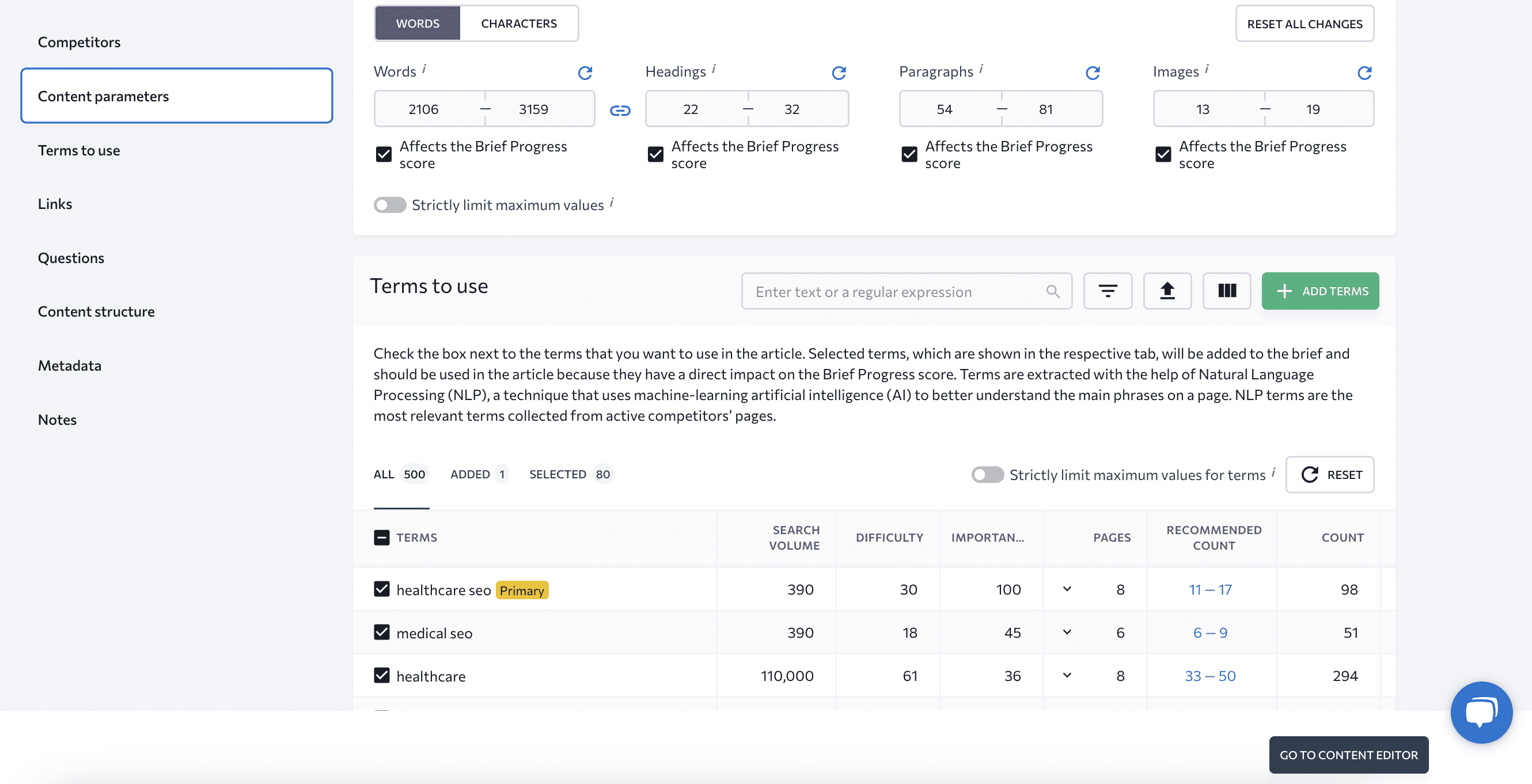
Prioritize E-E-A-T
Once again, understanding that the healthcare niche belongs to the Your Money or Your Life (YMYL) category is critical. When performing SEO for medical websites, be extra mindful of Experience, Expertise, Authority, and Trustworthiness (E-E-A-T) signals.
Here are some key tactics to use:
- Have your content authored or verified by credible medical experts
E-E-A-T ensures your website demonstrates a high level of expertise and authority. To achieve this, have your content written by doctors, researchers, or other accredited medical experts on your team. If medical practitioners do not write your content, ask accredited medical experts to fact-check and verify it.
- Showcase author or reviewer credentials and biographies
Reveal the brains behind the healthcare content you publish. Include author or reviewer names, bios, relevant medical credentials, etc. Manhattan Medical Arts follows this practice to show that the content on their blog is medically reviewed. They also show who the reviewer is to add to their credibility:
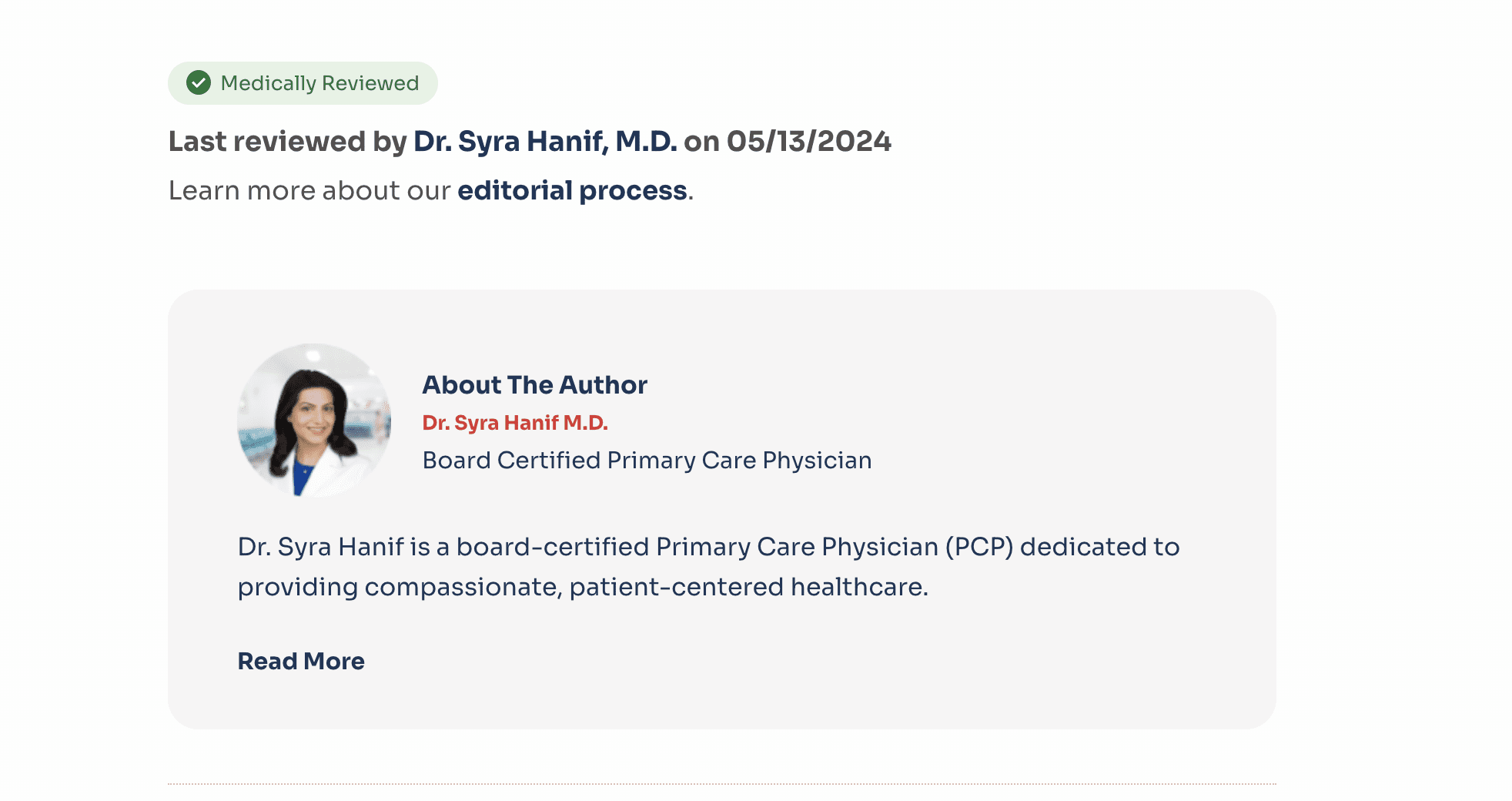
- Feature About Us or Our Team pages
Dedicate one of your pages to your team, and make sure it is easy to find. This reinforces your overall organizational authority. Highlight your staff’s credentials, qualifications, areas of specialization, and experience.
Here is a good example from the London Medical clinic, which includes both pages on its website. The About page describes the clinic’s growth over the years (and the benefits of choosing it) and features an extensive FAQ section. Its team page lists clinic specialists along with a short bio. If you click on the specific expert, you’ll be transferred to the dedicated page with more information about qualifications, experience, and specialization.
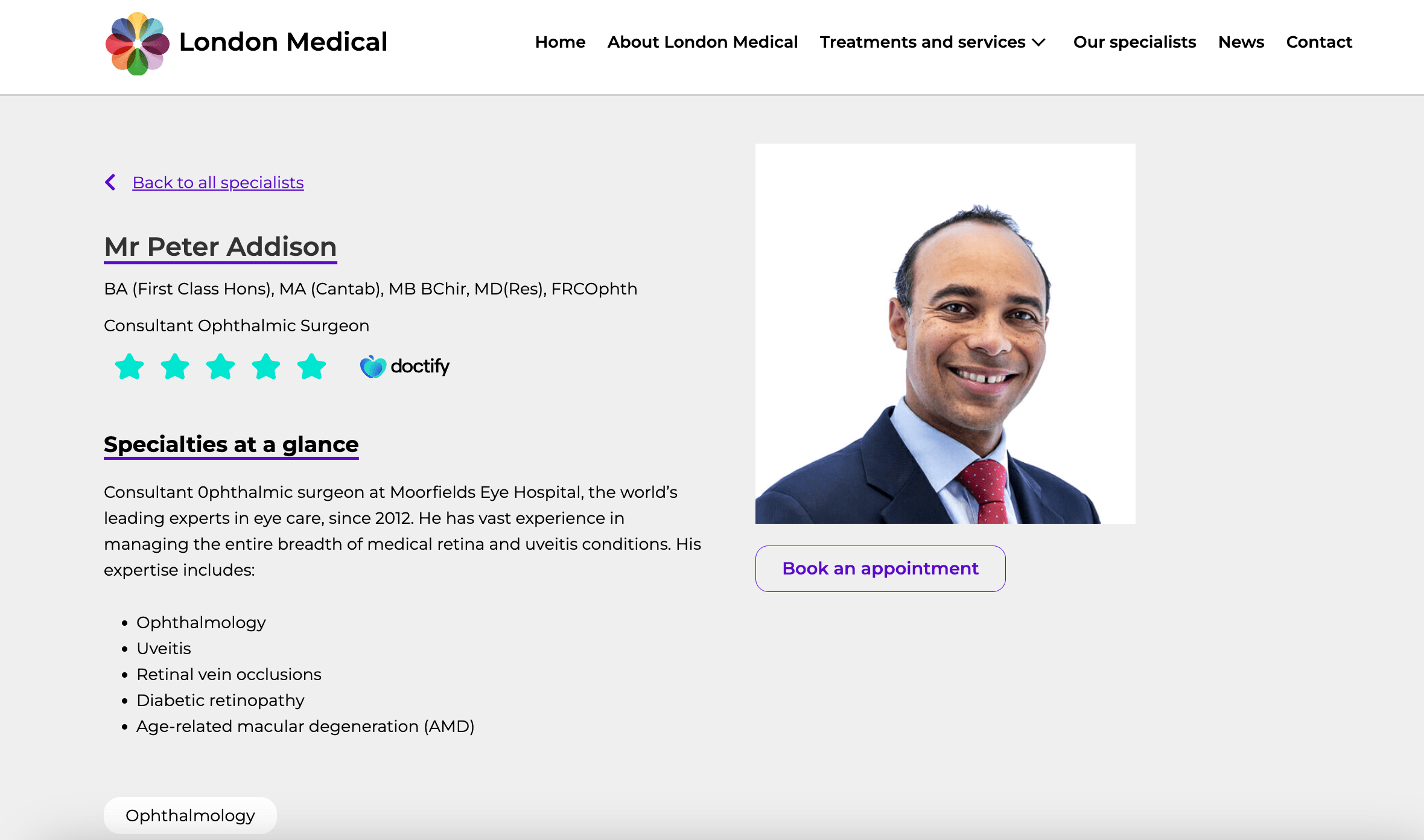
- Integrate additional trust signals site-wide
Demonstrate your team’s medical credibility and professionalism through different trust signals. Apart from the doctor’s information in the screenshot above, you can also see his rating from the healthcare review platform Doctify. This is one example of trust signals that you can use on your pages. You should also add professional certificates, licenses, awards, testimonials from satisfied patients, etc.
- Feature privacy policies, terms and conditions
Healthcare sites handle sensitive personal and medical information, so clear policies around data privacy and terms of use are critical. Ensure you have highly visible links to the privacy policy and terms & conditions pages. This demonstrates your commitment to transparency and protecting patient information.
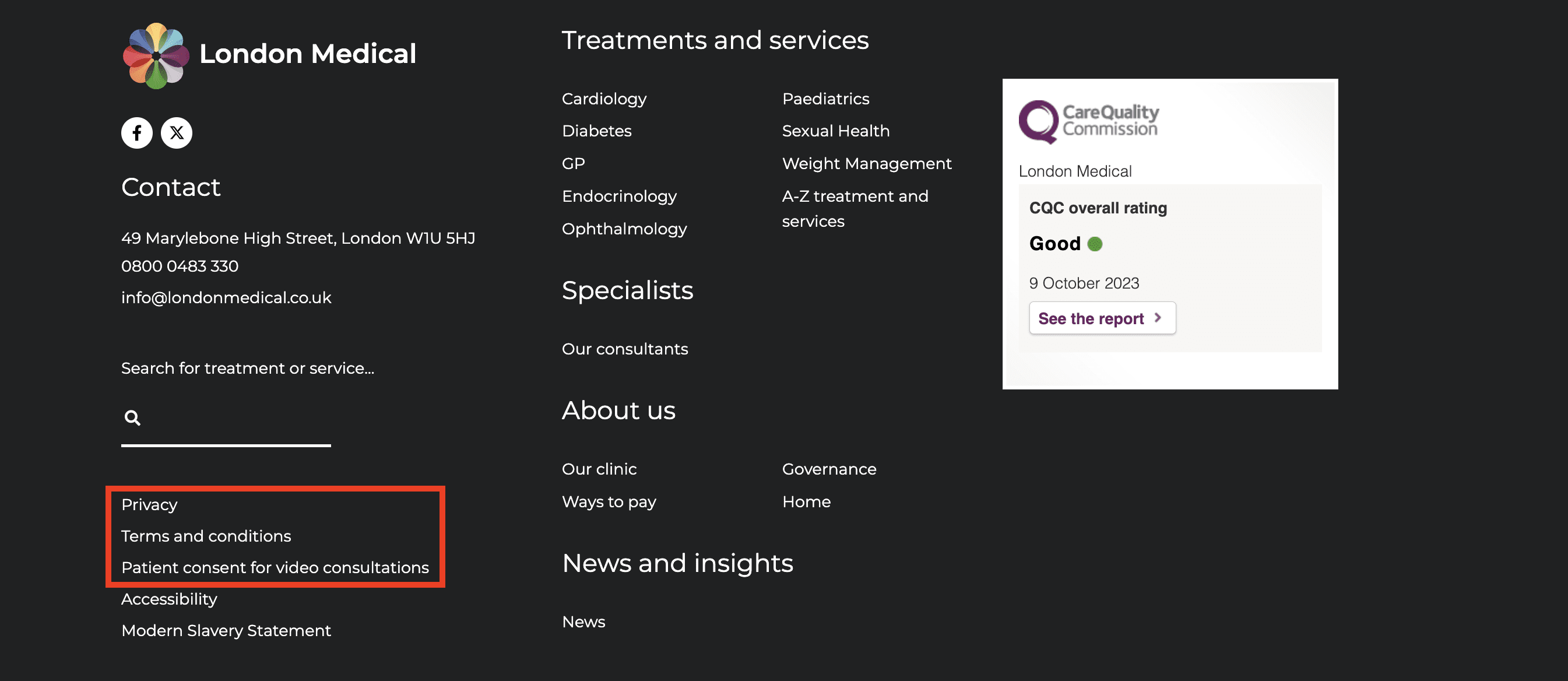
- Provide medical advice responsibly
When providing healthcare information online, be extremely cautious with the advice you offer. Any medical guidance can have real and potentially severe consequences if misunderstood or misapplied. Add notes to your publications that people shouldn’t self-diagnose or self-medicate based solely on online information. Your content is intended for general educational purposes and only qualified medical professionals can evaluate a person’s full medical history and provide appropriate counsel.
Follow best on-page SEO and internal linking practices
On-page SEO refers to all optimizations within your web page (content, HTML code, etc.) to make them rank higher for relevant search queries. There are several key on-page SEO best practices to incorporate across your healthcare site:
- Optimize for search intent
Search intent is about understanding what your potential patients are searching for and why. Your content should align with the intent behind queries.
For instance, the search query How to prevent seasonal allergies? has informational intent. This suggests that the user wants to get advice and recommendations for treating this condition (keep in mind responsible medical advice!). So, you may want to create a detailed blog post that answers this query and optimize it accordingly.
Those searching for Best dermatologist for kid have a transactional intent. They are down the purchasing funnel and are more ready to buy services. They simply don’t know whom to choose. In this case, you may want to create a service page describing the benefits of choosing your hospital and optimize it for this keyword.
But avoid keyword stuffing. Your content should read naturally. Mind readability as well because most of your readers aren’t doctors. So make sure your content is written in a way that non-medical staff can understand it.
- Add relevant keywords to title tags and H1 headings
These are critical elements of on-page SEO because they tell both users and search engines what your page is about.
The title tag appears on the Google search engine results page and at the top of your browser tab. Make it catchy, include your primary keyword at the beginning, and keep it under 60 characters.
Let’s say want to create a service page for diabetes treatment in your hospital. Your primary keyword can be Diabetes Treatment in London and your title may be Diabetes Treatment in London: [Your Hospital Name].
The H1 tag is usually the main heading on your page. Include your primary keyword into it and clearly state what the page is about. Continuing with the above example, the H1 for this page can be Personalized Diabetes Treatment in London
- Craft compelling meta descriptions for better click-through rates
A meta description is a summary that appears below your title tag in search results. A well-crafted meta description can improve click-through rates by enticing users to visit your site. Use relevant terms and keep your meta description under 155 characters.
Keep in mind, that adding a meta description to your page doesn’t guarantee this text will appear in Google SERP. Google can still choose the different part of your page text to display.
- Create user and search-engine-friendly URLs
Clean URLs are easier for users and search engines to understand. Make your URLs simple and descriptive and incorporate relevant keywords if possible.
Instead of yourwebsite.com/p=12345, use yourwebsite.com/diabetes-treatment-london.
- Optimize the internal linking architecture
Internal links connect related pages throughout your website. This allows users (and search engines) to better understand the structure of your site and improves navigation.
For example, if you have a blog post about treating diabetes, link to your diabetes treatment service page within the post, and also link other blog posts that are relevant to treating diabetes.
Use descriptive anchor texts and follow the page’s context.
Ensure proper website accessibility & UX
While attracting visitors through search is probably the main goal of SEO, an accessible and user-friendly experience once they arrive to your website is no less critical. If you fail at this point, your potential clients will just leave your website and possibly choose your competitor.
Ensure people of all abilities, impairments, and health issues can access and consume your website content and interact with it. Use:
- High color contrast ratios and adjustable text sizes
- Optimized button/link spacing and tap targets for different devices
- Detailed image alt text and captions for vision-impaired visitors
- Logical heading structures and keyboard navigation capability
Run regular accessibility audits and adhere to WCAG guidelines.
In terms of UX:
- Make sure your website has a responsive, mobile-optimized design that looks clean and professional.
- Build simple and clear site navigation through proper menu structures, internal linking, breadcrumbs, etc. Make it easy for users to orient themselves and move between pages.
- Ensure you have no broken or orphaned links and pages. They frustrate users and signal poor website maintenance to search engines.
- Create intuitive user flows. Guide users through a logical journey from initially getting answers to their health-related questions to discovering your healthcare services to booking appointments or finding a physical location through CTAs (calls to action).
- Optimize your healthcare website’s loading speed and user experience by improving Core Web Vitals metrics (loading performance, visual stability, responsiveness), optimizing images, and cleaning your code.
Do technical SEO for improved performance
Even the most beautifully designed healthcare website can suffer from behind-the-scenes technical SEO issues that undermine its search performance. That’s why conducting regular, comprehensive technical audits is so crucial when doing SEO for medical clinics. This allows you to identify and resolve medical SEO problems before they turn into chronic conditions.
Here are some key areas to inspect:
- Broken links, images, and non-200 URLs: Check your website for links, resources, images, or URLs that return any status code other than 200 (OK), which indicates that the request was successful. This is crucial both for UX and search engines. For instance, 3XX status codes are redirection codes. If set incorrectly, they can create redirect chains or loops or just lead to an incorrect final URL and users won’t be able to the content you want to show them. 4XX and 5XX status codes mean that access to the page can’t be granted at all.
- Duplicate content: Check your website for identical copies existing on separate pages and rewrite the text to make it unique. This also refers to titles, descriptions, headings, etc. If you can’t do this, use canonical tags to tell search engines which URL is the main one.
- Crawl and indexing errors: Make sure search engines can access and index your site. Your pages shouldn’t be blocked by robots.txt and noindex meta tags and should have internal links to them.
You can audit your website manually but it’ll require a lot of time. Tools like SE Ranking’s SEO Audit Tool are a more effective option. It detects all the issues mentioned above, detects accessibility and mobile usability errors, and more, and provides fix tips. You can also set up an audit schedule to keep your site’s technical health under control.
One more point: Add relevant schema structured data. Schema markups help search engines understand your website content better and enhance how your pages appear in search results. MedicalClinic markup will help you enrich your search snippets with locations, open hours, reviews, etc.
Implement Local SEO
Local healthcare SEO ensures your practice shows up prominently for geographically based searches like:
- Primary care physician near me
- Walk-in clinic in NYC
- Cardiologist in Cleveland
By optimizing for queries with local intent and adhering to factors that Google considers when selecting search results (relevance, distance, and prominence), you increase the likelihood of being found in local search and getting featured in Google Local Pack (a block in the form of a map on the search results page that displays places related to your query).
Here are some of the key local SEO aspects to focus on:
- Accurate NAP (Name, Address, Phone) information on your website: Make sure your healthcare business details are prominently displayed on your website (in the header or footer, and on your contact page).
- Claim and optimize your Google Business Profile: This tool lets you manage how your business appears on Google Search and Maps. If you haven’t already, create and verify your GBP or claim the existing one if it’s yours. Complete your profile with accurate information (NAP, business hours, services offered). Add high-quality photos of your clinic, and keep your information updated.
- Provide links to Google Maps: Embed Google Maps on your contact page and include a link in your address details. This helps users get directions and view your location easily.
- Submit to authoritative medical and local directories: There are many online directories, databases, and listing sites for healthcare providers to be listed on. Some of them are general like Yelp, and others are specialized healthcare directories, like ZocDoc, WebMD, HealthGrades, RateMDs, AMA, ADA, etc.
- Encourage patient reviews: Positive online reviews from real patients are one of the factors in the decision to choose a doctor. Encourage clients to leave reviews, monitor them, and respond professionally to any negative feedback.
Monitor your online presence using SE Ranking’s Local SEO Tool. With this tool, you can monitor listings, manage customer reviews, manage your GBP, identify terms to use in your local optimization campaigns, and much more.
Keep an eye on your local positions with tools like Local Rank Tracker. It shows organic local and map rankings and helps you track local SERP features and monitor competitors.
Get backlinks and mentions
Off-page search engine optimization refers to activities outside your website that help build your domain authority. Guest posting, digital PR, and providing expert quotes initiatives are two main areas to focus on. Top search engines like Google analyze a site’s backlink profile (the quality of backlinks you get) and overall reputation to determine how authoritative and trustworthy that source is and whether it deserves to be shown in search results for a specific query.
Here’s what you can do for off-page optimization:
- Create guest posts for reportable third-party websites. Your team is a highly knowledgeable asset you can use. Have them author insightful content and publish it on other reputable healthcare blogs, websites, and media. This way, you’ll get backlinks to your site and build your team’s reputation as experts people should listen to.
- Provide expert quotes from your doctors. Journalists are constantly looking for credible sources for commentary on different topics. In your case, this can be healthcare news, studies, and trending topics. Use platforms like HARO (Help a Reporter Out) to provide quotes and get mentions.
- Run proactive digital PR campaigns. Digital PR refers to earning online media coverage to raise brand awareness. Create newsworthy material on your original research studies, share clinical trial data and healthcare statistics, describe new medical technologies and treatments, and pitch these assets to different media. Such materials can earn you backlinks and improve your brand’s online presence.
Important note!
Your strategy would be complete without tracking SEO progress. As you implement various tactics, monitor how they impact your website’s performance in search. Define metrics to evaluate medical SEO success, track and analyze them, and adjust your optimization approach.
How to implement a healthcare SEO strategy
There are a couple of paths you can take depending on your resources, budget, and SEO expertise.
Path #1: Hire a medical SEO marketing expert
If you’d prefer to put your SEO in the hands of proven professionals, partner with a specialized healthcare SEO agency. These firms know all the nuances of optimizing medical/healthcare sites.
A simple way to find an SEO agency for your medical business is through SE Ranking’s Best SEO Agency Directory. This is a special platform that features top firms providing digital marketing and SEO services. Just filter by the healthcare industry and choose desired services, location, and languages. And you’ll get a list of agencies that meet your needs.
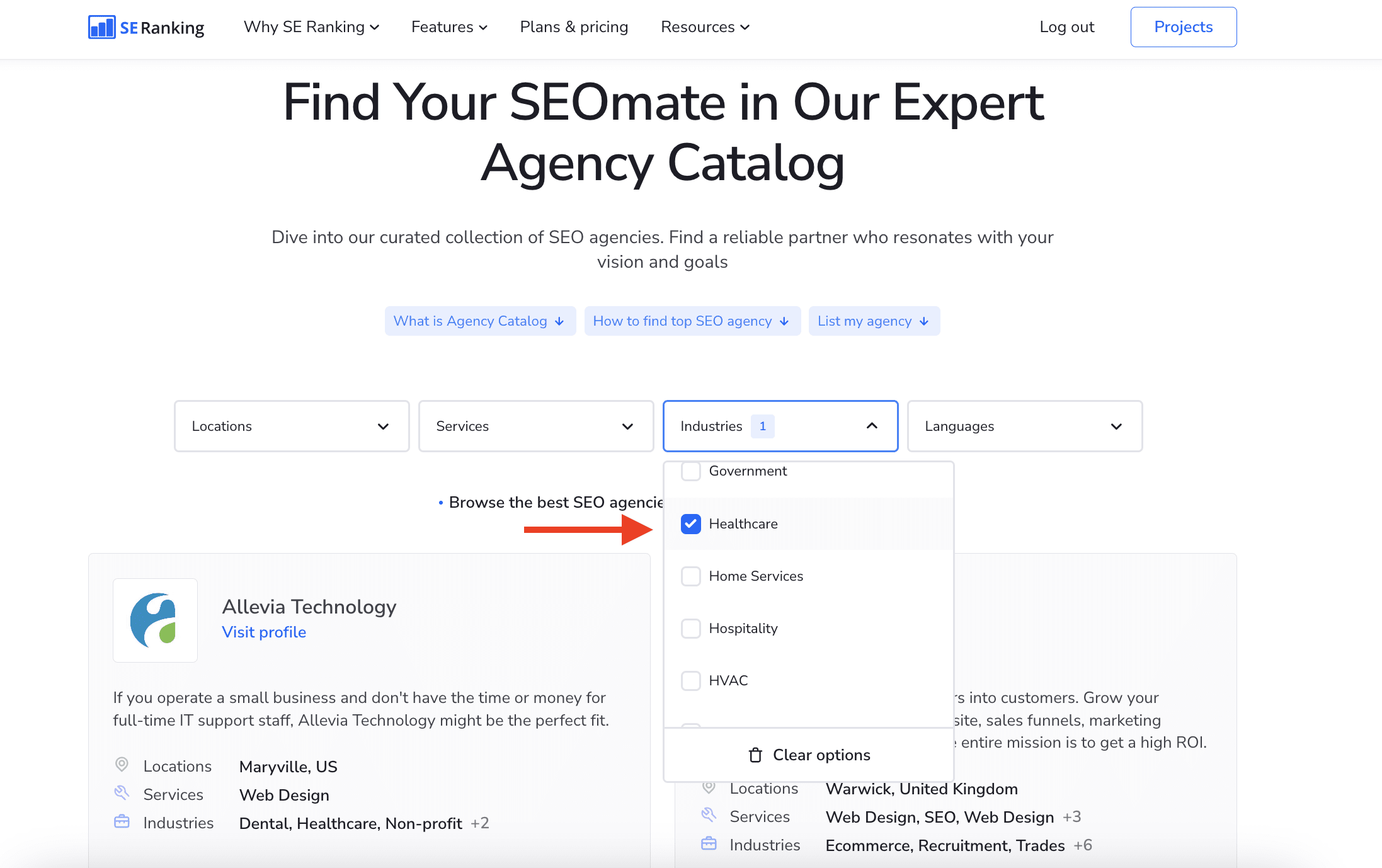
To learn more about a specific agency and its healthcare SEO services, check its profile and go to its website via a link. You can also contact the agency directly from our directory.
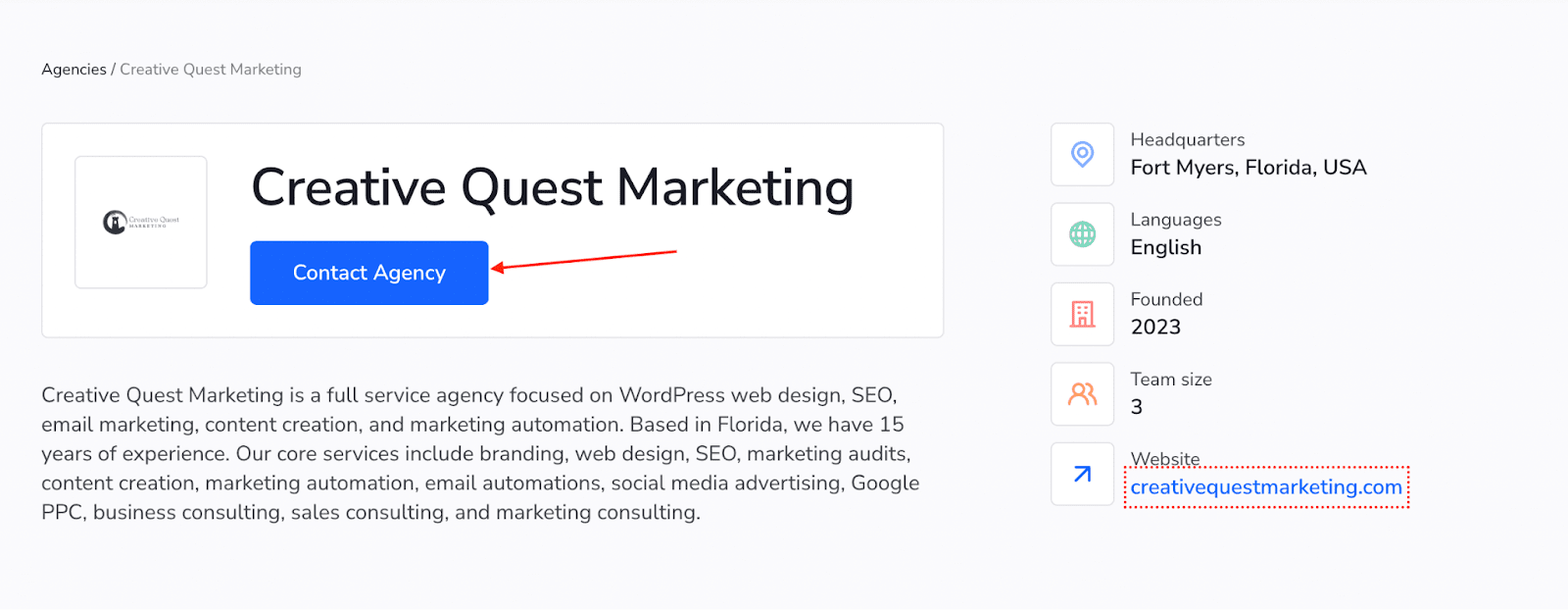
Path #2: Implement medical SEO yourself
You can do SEO yourself but it requires a lot of your time and resources that you could have otherwise put into running your practice. If you have an in-house specialist providing medical SEO services, they can help you.
In both cases, you’ll need an intuitive and comprehensive SEO tool like SE Ranking to automate the process. This solution provides instruments for every aspect of a healthcare SEO:
- Competitive and keyword research
- Keyword position tracking
- Technical site auditing
- On-page and off-page optimizations
- Content marketing
- Local marketing
- Etc.
With this platform, you’ll access high-quality and accurate SEO data in an easy-to-understand format. Generous limits won’t restrict your ability to fully use the tools as needed for your SEO.
The bottom line
We hope that this medical SEO guide helped you better understand why implementing a comprehensive SEO strategy is so crucial for your business. Create quality content fueled by medical expertise, optimize on-page elements, prioritize E-E-A-T, build a healthy backlink profile, run technical audits, and more. This will open up pathways for people to find your organization.
